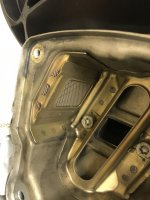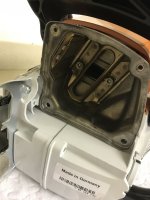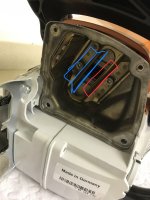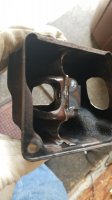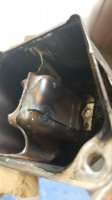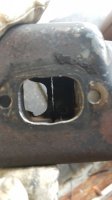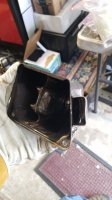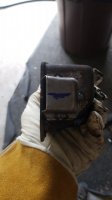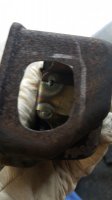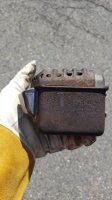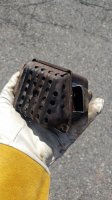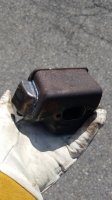You are using an out of date browser. It may not display this or other websites correctly.
You should upgrade or use an alternative browser.
You should upgrade or use an alternative browser.
Old Dirty Feta and the MS500i--the Hi-Tech Wood Lobotomizer
- Thread starter AlfA01
- Start date
blsnelling
Friend of the Riff Raff
- Local time
- 1:59 AM
- User ID
- 447
- Joined
- Jan 8, 2016
- Messages
- 1,114
- Reaction score
- 6,234
- Location
- Franklin, OH
If I'm not mistaken, the 462 muffler is made the same way.Some more theory for discussion...The muffler design controls and limits exhaust flow in order to probably passify EPA standards and provide back pressure.
Here's a bit of a diagram on the pic to explain why I believe this thing has a strange exhaust note when stock and why the heat tends to quickly build up.
Generally, all mufflers are restricted in someway. And, they build up heat. Some worse than others. This one in particular looks open, but...
Stihl has forced gases leaving the cylinder and directed them toward the flywheel side of the exhaust can. The outlet is on the PTO side and at the far rear of the can.
The old exhaust(blue arrows) then has to build enough pressure to force it's way past the stream of incoming fresh exhaust(red arrows), which creates the strange exhaust note.
Think of driving in a car and having the window opened to just enough where you get that mind numbing percussion sound.
Too much air rushing in and filling the car, while the air inside the car is fighting to get out and normalize--ie, MS500i exhaust and the funky sound effects (buffeting).
The green indicates where I modded the flow baffle as of this point in the mods. It's not necessary/easy to take out the whole bit--a lot of spot welds going on there.
I like the reinforcement the cage adds to the back of the muffler...pretty thin metal on these new muffs.
View attachment 181332
Backtroller
Here For The Long Haul!
- Local time
- 12:59 AM
- User ID
- 349
- Joined
- Dec 31, 2015
- Messages
- 2,794
- Reaction score
- 11,349
- Location
- Land of Badgers
blsnelling
Friend of the Riff Raff
- Local time
- 1:59 AM
- User ID
- 447
- Joined
- Jan 8, 2016
- Messages
- 1,114
- Reaction score
- 6,234
- Location
- Franklin, OH
+1I agree. This is a can for noise deflection and detuning. Its not a stepped, tuned, or equal length header. Turbulent air is beneficial within an intake tract for fuel suspension and flow within a vacuum. Exhaust should remain hot and flowing in as direct a stream as possible with little to NO back pressure for greatest performance.
stihlman441
Super OPE Member
- Local time
- 5:59 PM
- User ID
- 850
- Joined
- Feb 9, 2016
- Messages
- 144
- Reaction score
- 673
- Location
- near Geelong Australia
- Local time
- 1:59 AM
- User ID
- 2523
- Joined
- Jan 24, 2017
- Messages
- 4,960
- Reaction score
- 22,966
- Location
- Berkshire County, Massachusetts
Let's be honest for a minute. The saw muffler is something that is often over thought. These are cans with no other purpose than to dull sound and performance. The muffler exit being as small as it is and in the location that it's in is no mistake. As exhaust gasses leave the exhaust port and collide with the front muffler cover, the exhaust gasses natural course of action is to deflect and push to the sides of the can, making side or corner exits most effective for performance and flow in a thermodynamic sense. The OEM muffler opening being as small as it is, is in the right location for its design. The exit size is the bottleneck in this case as it has no baffle cage.So that makes the 500 Exhaust not adequate to the description.
462 muffler directs gas straight to front wall
Sorry for the long winded post lol
Evansaw
Pinnacle OPE Member
- Local time
- 8:59 AM
- User ID
- 4633
- Joined
- Nov 20, 2017
- Messages
- 1,038
- Reaction score
- 4,653
- Location
- Greece
Let's be honest for a minute. The saw muffler is something that is often over thought. These are cans with no other purpose than to dull sound and performance. The muffler exit being as small as it is and in the location that it's in is no mistake. As exhaust gasses leave the exhaust port and collide with the front muffler cover, the exhaust gasses natural course of action is to deflect and push to the sides of the can, making side or corner exits most effective for performance and flow in a thermodynamic sense. The OEM muffler opening being as small as it is, is in the right location for its design. The exit size is the bottleneck in this case as it has no baffle cage.
Sorry for the long winded post lol
English being your mother language you described it better
- Local time
- 1:59 AM
- User ID
- 319
- Joined
- Dec 29, 2015
- Messages
- 9,614
- Reaction score
- 63,350
- Location
- Strong Island NY
Thanks for the kind words.I generally go over 100% on exhaust deflectors. I do try to add baffles to tame the sound.
The more the gasses have room to hit each other before exiting, the better the sound reduction.
Think about the fancy suppressors above and then about a large long oil filter or soda bottle on the front of a gun. If you create enough area, it can match or exceed all the performance of the little suppressors.
That’s the reason Stihl puts their deflectors all the way on the back of the cans now. Even their classic front outlets always had a turn on them. You are far more educated and you are building wonderful saws. My question is why in their strongest saw the 661 there’s just a baffle with straight exit, moving gasses straight to front wall and not angled at all. So gasses exit straight to the front kinda “spaying” the can. The velocity should be so high that maybe returning gasses are absorbed by the exhaust port.
Sorry for bold just saving time to type on phone screen.
Dan, there is room on the Fly side front half (past the flange) for a deflector. If you think it out, you can add one that you modify with a small inner deflector welded to it. That way the waves must hit the front cover and bounce back before the exit. That’s where I add them on the 261/361/362. Just use rivet nuts. Trying to weld anything to whatever type of stainless Stihl uses for those cans is an exercise in frustration.
It’s all about noise cancelling without restricting flow. You can’t get a pipe effect with a muffler.
I’m not sure why the 661 does it one way and these new wonders do it another. I would bet good money on the fact that it’s no accident though.
Heat plays a role also. Gas that’s cooled takes up less area and can exit through a smaller opening than hot expanded gas can. The sound waves stay the same though.
My bet is that they are rotating the axis of the outlet for the exhaust from port to muffler for the above reasons. It diffuses the stream more, causes more collision of waves, and makes it swirls around the can more. Theoretically it should spend more time there and there should be less Dead space that doesn’t perform its function.
At least that’s what I see happening.
For better power, I’d remove that inner weird vertical baffle completely and maybe add a piece of metal to stop short circuiting out the stock deflector. For all out power, as nearly every race saw does, big hole right out front cover. That baffle is creating a primary small muffler in actuality with 100% exit size, then the actual muffler is a second one/resonator. Likely why the sound is different.
Last edited:
- Local time
- 1:59 AM
- User ID
- 319
- Joined
- Dec 29, 2015
- Messages
- 9,614
- Reaction score
- 63,350
- Location
- Strong Island NY
- Local time
- 1:59 AM
- User ID
- 319
- Joined
- Dec 29, 2015
- Messages
- 9,614
- Reaction score
- 63,350
- Location
- Strong Island NY
The old tech version of this is that 460/046 muffler. It has an inner baffle most remove, but some testing has shown it helps performance.
Evansaw
Pinnacle OPE Member
- Local time
- 8:59 AM
- User ID
- 4633
- Joined
- Nov 20, 2017
- Messages
- 1,038
- Reaction score
- 4,653
- Location
- Greece
Thanks for the kind words.
I’m not sure why the 661 does it one way and these new wonders do it another. I would bet good money on the fact that it’s no accident though.
Heat plays a role also. Gas that’s cooled takes up less area and can exit through a smaller opening than hot expanded gas can. The sound waves stay the same though.
My bet is that they are rotating the axis of the outlet for the exhaust from port to muffler for the above reasons. It diffuses the stream more, causes more collision of waves, and makes it swirls around the can more. Theoretically it should spend more time there and there should be less Dead space that doesn’t perform its function.
At least that’s what I see happening.
For better power, I’d remove that inner weird vertical baffle completely and maybe add a piece of metal to stop short circuiting out the stock deflector. For all out power, as nearly every race saw does, big hole right out front cover. That baffle is creating a primary small muffler in actuality with 100% exit size, then the actual muffler is a second one/resonator. Likely why the sound is different.
I m lacking to explain my thoughts completely and correct as English aint my language however the mind is there removing the baffle.
Thanks for responding
nohoff
professional flusher
- Local time
- 7:59 AM
- User ID
- 4033
- Joined
- Sep 11, 2017
- Messages
- 478
- Reaction score
- 2,007
- Location
- Germany
I know that Stihl has a team that is tweaking the sound of pro saws, so the user hears the performance.
Those guys do a lot of research for silent mufflers and getting the right sound out of the muffler...
Those guys do a lot of research for silent mufflers and getting the right sound out of the muffler...
StephK87
Pinnacle OPE Member
- Local time
- 7:59 AM
- User ID
- 921
- Joined
- Feb 21, 2016
- Messages
- 378
- Reaction score
- 4,363
- Location
- Germany
In my opinion the new stihl saws are a lot, but definitely not quiet  they're getting louder and louder, look at the evolution of the 261, or the noise of the 462 or 500i. 121db! Lots for a stock saw. But the benifit of these more unrestrictet exhaust designs is a better throttle response and spool up.
they're getting louder and louder, look at the evolution of the 261, or the noise of the 462 or 500i. 121db! Lots for a stock saw. But the benifit of these more unrestrictet exhaust designs is a better throttle response and spool up.
Last edited:
Evansaw
Pinnacle OPE Member
- Local time
- 8:59 AM
- User ID
- 4633
- Joined
- Nov 20, 2017
- Messages
- 1,038
- Reaction score
- 4,653
- Location
- Greece
I know that Stihl has a team that is tweaking the sound of pro saws, so the user hears the performance.
Those guys do a lot of research for silent mufflers and getting the right sound out of the muffler...
Yep their technique is parallel to the automotive industry
That was my initial thought and I started thinking about the weird exhaust design
- Local time
- 1:59 AM
- User ID
- 319
- Joined
- Dec 29, 2015
- Messages
- 9,614
- Reaction score
- 63,350
- Location
- Strong Island NY
- Local time
- 1:59 AM
- User ID
- 319
- Joined
- Dec 29, 2015
- Messages
- 9,614
- Reaction score
- 63,350
- Location
- Strong Island NY
Similar threads
- Replies
- 0
- Views
- 253
- Replies
- 4
- Views
- 788








